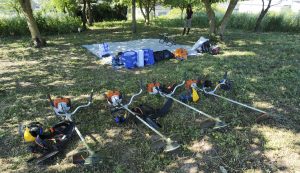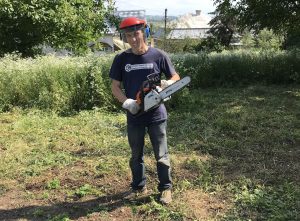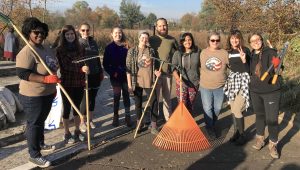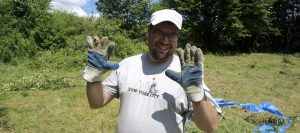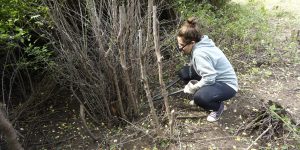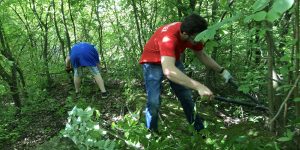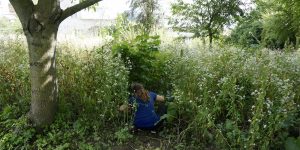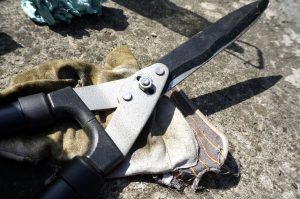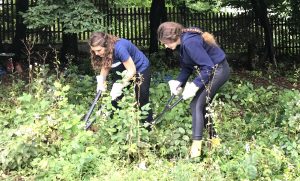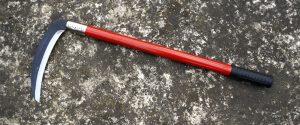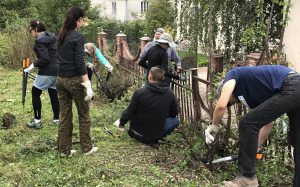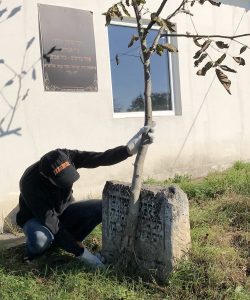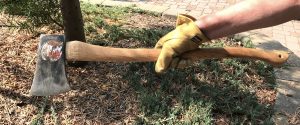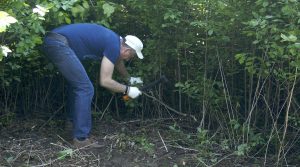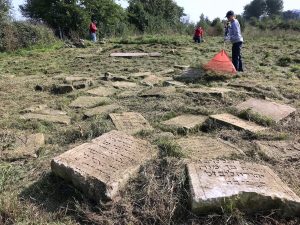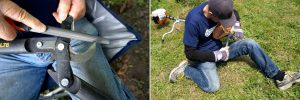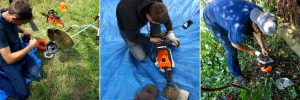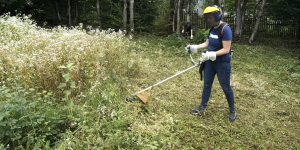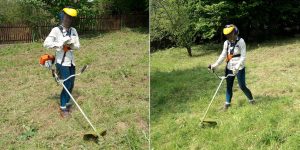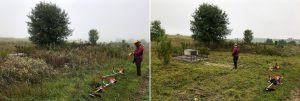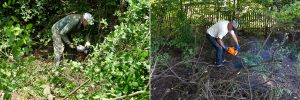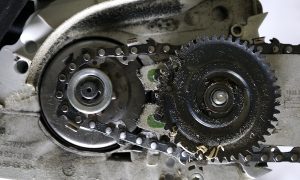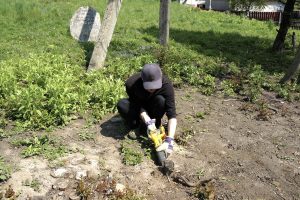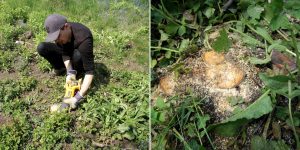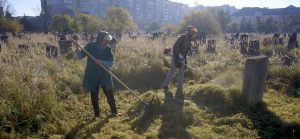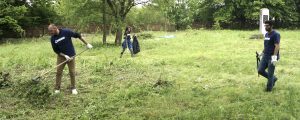![]() Ця сторінка також доступна українською.
Ця сторінка також доступна українською.
Introduction
This page provides an overview of the most common tools used to control wild vegetation growing in and around Jewish cemeteries and mass grave sites in western Ukraine, based on hands-on experience in the region in recent years. The information provided here coordinates with practical guidance on a variety of topics relevant to vegetation clearing and site cleaning on the guide page, and helpful external information and advice offered in articles and videos linked to the references page also on this website.
The information here is grouped in sections on safety, hand tools, power tools, and suggested sources for tools to be used in western Ukraine. Subcategories within each tool section list the tools found to be most useful with details to describe their common variants, typical and atypical uses, known issues of safety or other risks, typical costs to acquire and maintain the tools, and the normal expected wear life of the tools.
The range of tools described on this page is limited to those which aid the clearing and maintenance of Jewish burial sites without active landscaping plans and projects; tools to aid grading, planting, and maintaining new intentional vegetation are excluded here, though many of the same manufacturers mentioned here also produce tools for those purposes. Thus most tools described here are “cutting” tools, though it is important to also study the exceptions below.
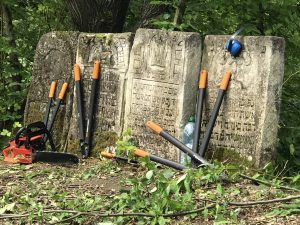
Hand and power tools for clearing vegetation during a rest break at the mass grave near Rudky. Photo © RJH.
Note that the work of clearing and controlling wild vegetation in cemeteries is neither gardening nor forestry, but somewhere in between, and normally varies in style and intensity as a burial site is transformed by the work. For efficiency and economy, tools should be selected for quality and sized for landscape maintenance rather than “home and garden” use; with routine care these tools will last much longer and be better able to manage the range of common problems encountered in cemeteries and elsewhere.
In order to give further guidance to less-experienced project leaders, for many of the tool subcategories below one or more suggested tool manufacturers or suppliers are named and sometimes linked, and the illustrations on this page sometimes refer to specific manufacturers’ websites. These suggestions are not exclusive and in most cases there are other providers of comparable-quality tools available in western Ukraine or nearby; internet searches and browsing the options at tool suppliers, garden supply shops, and bazaars in the region will quickly highlight those other options. We are not affiliated with any tool maker or supplier, and no payment or gifts to the authors of this page were provided by any tool manufacturer or distributor named here.
We continue to gain knowledge and experience through our own site work and from working with others at their project sites, and will add to and refine this page over time. Suggestions and advice from others is welcome; please feel free to email us via the contact page at Rohatyn Jewish Heritage.
Safety
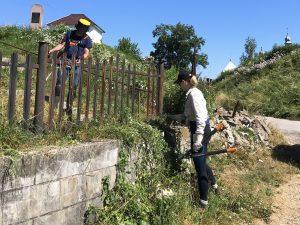
Most cemetery clearing projects present risks to volunteers from plants, tools, debris, and other volunteers. Photo © RJH.
Tools extend and amplify human capabilities in performing various tasks, but usually also the risks inherent in performing those tasks. Tools for vegetation clearing typically incorporate one or more blades or other cutting edges, which are applied with great force or speed or both. Thus cutting tools are inherently dangerous to people, to the tools themselves, and to other objects at the work site (e.g. headstones, other structures, wild and domestic animals, etc.). To maintain reasonable safety, workers should be trained in tool inspection and use, and should remain alert at all times during use, both to the tool operation and to the environment surrounding the user and the tool edge. The guide page on this website covers a number of other important health and safety concerns and protections related to cleaning and clearing cemeteries and mass grave sites in western Ukraine, so only tool-related issues are discussed here.
Hand tools for vegetation clearing are not typically sold with user safety guides, but mature common sense is usually sufficient to protect workers and bystanders from harmful accidents; tools should not be given to children for this reason, even if they express interest in helping the work. Tools which combine sharp edges with large mass (e.g. axes) or with high mechanical advantage (e.g. loppers) are usually the most dangerous, so these may require training on site before they are used by inexperienced workers, or perhaps should be reserved for use by more experienced people. Even tools which allow a greater measure of blade control (e.g. hand saws), which may not be especially dangerous themselves, can create unsafe conditions in inexperienced hands when partially-cut tree limbs break and fall, or if left with the blade exposed in an area where people may walk and stumble. Otherwise safe hand tools are sometimes used to do potentially dangerous tasks, such as felling trees or removing large tree limbs; this work should only be performed by professionals or others with real experience.
Power tools for vegetation clearing are much more dangerous than hand tools because of the significant force and speed they can apply to a cutting edge, and the debris (plant cuttings, small stones, glass, etc.) which they can throw at high speed in the direction of the user and other workers in the area. These tools are usually sold with user guides including detailed safety instructions, warnings, and recommended personal protection guards and clothing which should be available to and read by anyone who will use the tools at a project site, even people with prior experience using similar tools. Regrettably, some new users of motorized vegetation-cutting tools assume that their ability to operate other machinery (cars, motor drills, etc.) will transfer easily so they ignore learning opportunities and safety warnings before they go to work, to the detriment of the tools, cemetery features such as headstones, other people working at the site, and themselves. Chainsaws are notoriously dangerous in inexperienced hands, and even experienced users often have no real knowledge of the principles and risks in felling trees; there is an endless supply of internet videos capturing “chainsaw fails” which should deter people from risking their (and others’) life and limb, but somehow don’t. In addition to manufacturers’ tool safety guides and internet cautionary videos, there are also educational articles, pamphlets, and videos on the references page to support anyone who wishes to learn safe power tool use.
In addition to gloves, which are typically provided by project leaders to all workers (and described below), everyone who plans to work at a burial site in any capacity should bring and wear sturdy protective clothing, especially footwear. Covering arms and legs with heavy shirts and trousers will prevent most scratches and burns, but closed-toe shoes are needed to shield workers’ feet from many hazards on the ground, and ankles need the extra protection against sprain injuries provided by stiff high-sided safety or hiking boots. This is especially true for any worker using power tools, to ensure good footing while using the tools and as an extra measure of protection from the fast-moving tool blades.
Hand Tools
As is often demonstrated by workers using traditional field work methods in western Ukraine, almost every task in clearing vegetation from burial sites can be performed using hand (manual) tools, and the few tasks which require large motorized tools, e.g. felling and removal of large trees, are generally best left to local experts for reasons of safety, cost, and efficiency. Further, some tasks can only be performed with hand tools, e.g. raking, and cutting/removing poisonous plants. Even when motorized tools are used for some tasks at a cemetery or mass grave, much of the preparatory and finishing work is best done with slower and more precise hand operations, so selected hand tools make a useful complement to an assortment of motor tools. Issues of safety and tool maintenance are just as important for all hand tools as for the motorized versions, but in general the risks during use, training requirements, and skills needed to sharpen and maintain hand tools are lower. For new projects run by inexperienced volunteers, several days of work with only hand tools can help develop strategies for site clearing and for assembling tool sets best suited to the site.
Gloves
Gloves serve as personal protection for many tasks in clearing vegetation from cemeteries and mass graves, toughening and safeguarding the user’s hands while using tools or grasping rough surfaces. Except for some tool adjustment work requiring precise touch, almost every task related to burial site clearing and cleaning is improved by the use of gloves. Inexperienced workers will sometimes decline to wear gloves at the start of work, but almost everyone will choose to wear them after a few hours of work.
Common variants: So-called “work” gloves and “gardening” gloves come in many styles made of a great variety of materials; often users have their own preferences from past experience in similar work. Common glove materials include suede/leather combinations which are very durable but become stiff after exposure to water, cotton weave (very popular in western Ukraine, often with a rubber coating for improved tool grip), woven synthetic blends (a more durable alternative to cotton), and several types of flexible and waterproof molded plastic. Gloves should come in a wide range of sizes, but for many glove styles the only sizes common in western Ukraine are intended for large hands, even though women with smaller hands do as much practical vegetation clearing work as larger men.
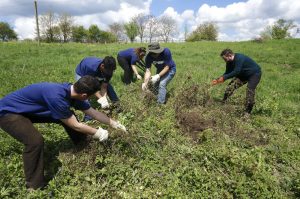
Gloves used to extract old wire fencing by hand from overgrown vegetation in the old Jewish cemetery of Rohatyn. Photo © RJH.
Best uses: Gloves serve as essential protection during the collection and removal of garbage and construction debris, while dragging cuttings from wild or overgrown vegetation in other clearing work, and when pulling stinging nettle up by the roots. Often gloves are useful for protecting hands from blisters and abrasion during extended use of hand tools, and from flying debris during use of power tools.
Other uses: Thick leather or similar gloves can reduce puncture wounds from stiff thorns, but full protection requires wrapping a gloved hand in additional layers (e.g. a rag or loose t-shirt). Rubber and plastic gloves can somewhat protect skin on hands from poisonous plant sap when no long-handled tool is available, but the gloves must be carefully discarded immediately after use.
Issues: For both safety and hygiene reasons, we recommend to allocate at least one pair of gloves to each person clearing at a burial site, and ask each worker to keep their gloves. When the work involves handling irritants, thorns, or poisonous plants, gloves should not be exchanged between workers and usually should be discarded immediately after use.
Cost to acquire: Depending on materials and construction, gloves purchased in western Ukraine range in cost from about US$0.50 to US$4.00 per pair. More expensive and specialized options are available, but seldom needed.
Cost to maintain: Some types of gloves can be washed and rinsed for reuse, but most should be discarded when heavily soiled, oily, or damaged (holes).
Tool life: Lightweight gloves will last a day or more of continuous use if the materials handled are without thorns and other sharp edges. Sturdy gloves with suede or leather contact surfaces typically last for several days of hard use, sometimes much longer; these gloves will become stiff after wet use, but if cleaned with clear water will usually become flexible again with normal use.
Manufacturers: There are many good styles of gloves available in western Ukraine; specific brands need not be identified, as most gloves can be evaluated by users to suit their own needs for the tasks at hand.
Notes: No single glove type will serve any user well for every common task in cemetery maintenance; it is best to provide a variety of glove types and sizes for every worker, and replace stock as gloves become worn or damaged.

Gloves protecting volunteers clearing vegetation, construction debris, and garbage from Jewish cemeteries and mass graves. Photos © RJH.
Loppers
Loppers are long-handled cutters with short blades generally used for trimming small branches of trees and shrubs or felling young trees and entire woody shrubs. Essentially long-handled pruning shears, the long arms on loppers provide significant mechanical advantage to easily cut through wood of a few years’ growth.
Common variants: Blade styles include bypass (the cutting blade slides past the hook blade, like scissors) and anvil (the cutting blade stops on the anvil face); bypass blades cut quicker and cleaner, but are more easily damaged by hard materials. The cutting mechanism may be a simple pivot like ordinary scissors or may include a cam or gear to multiply force or expand the blade opening. Handle styles include round and oval cross sections, made of steel or fiberglass; oval styles are typically stiffer and stronger, and/or lighter, but construction details determine the actual performance. Handle lengths range typically 40cm to 80cm (16in. to 32in.); some have telescoping extensions to 100cm (40in.) or more. Handles 60~70cm in length are easier for smaller workers to manage, and for work in dense thickets, but for most project work handles 75~80cm in length provide a wider range of cutting diameters and the best overall utility.
Best uses: Cutting live wood up to 5cm diameter, i.e. woody shrub and small tree trunks as well as smaller branches of larger trees. A good general-purpose tool for clearing vegetation up to a few years of growth, i.e. for annual site maintenance. Also useful for pruning low branches on larger trees and thinning undergrowth beneath mature trees.
Other uses: Cutting thorny vines (e.g. blackberry) and cutting vegetation around headstones, fences, utility poles, concrete, and other hard objects where motor tools cannot be used safely.
Issues: Attempting to cut oversize branches or large-diameter dead and dense wood can damage lopper blades and hinge mechanisms. Accidentally cutting metal wire and cable or other hardened inorganic materials can nick or damage blades beyond recovery by resharpening. The high mechanical advantage of the mechanism means softer materials can be cut with little resistance, so care must be taken to avoid harming the user, bystanders, and desirable plants at the site.
Cost to acquire: In western Ukraine, high-quality long-handled bypass loppers cost up to US$60 each depending on tool quality and source; shorter examples cost less. The same tools purchased in the US from large retailers typically cost about 30% less. Lower-quality loppers available in Ukraine may cost only US$20 per pair, but experience shows that these tools may not last for more than a day of normal cemetery work.
Cost to maintain: Loppers typically need only cleaning with a soft brush and soapy water after a day of use to remove hardened plant sap and abrasive dirt. Inspection during or after use may suggest adjustment of the pivot and gear screws to eliminate a gap between the blades (or to offset blade wear in anvil styles). Occasional blade sharpening with a fine file can remove small nicks in the blade edge. None of these maintenance tasks has any significant cost, and all can be done at the work site.
Tool life: Loppers reach end of life when either sharpening the cutting blade removes too much metal for the blade to close completely, or the pivot and/or gear mechanism is distorted or damaged so that the blade does not close tightly. In lower-quality loppers, end of tool life may also result from distortion of the handles or other parts from the high force used to cut large branches. A good pair of loppers used carefully and normally maintained can last for 50 or more days of regular work.
Manufacturers: Many well-known tool manufacturers make loppers available in western Ukraine, and a large number of low-cost tools from other sources are also available. Higher-quality loppers are made by Fiskars, Gardena, and others.
Notes: See the references page on this website for several excellent articles on selecting and using this and other hand tool types. See also the tool manufacturers’ websites for user manuals and other information on tool selection and use.
Pruning Shears
Pruning shears (also called secateurs) serve a similar purpose as loppers (cutting and pruning) but typically work on smaller-diameter branches and shrubs; pruners are of similar design to loppers but with much shorter handle length. Although useful for common gardening tasks in maintaining decorative plants, pruning shears have limited usefulness in the large-scale clearing work common in cemetery care in western Ukraine; usually a single pair is sufficient for the few tasks which are not easily managed with loppers.
Common variants: Like loppers, blade styles include bypass and anvil; the scissor action of bypass shears makes them familiar and easy to use. Some types include gears to amplify mechanical cutting force, and ratchets to lock branches in place for secure cutting. One manufacturer (Fiskars) makes almost 20 different types with various combinations of features and blade types.
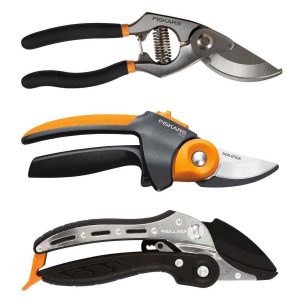
Common pruning shears (top), with compound gear to amplify cutting force (middle), and with ratchet to grip branches at the cut (bottom). Images © Fiskars.
Best uses: Light-duty cutting and pruning of branches and shrub stems up to about 20mm diameter. Pruning shears are small enough to carry in a jacket pocket or wear in a holster on a belt, so they can be available for occasional use.
Other uses: Because pruning shears can be operated with one hand, leaving the other hand free to pick up and move vegetation, the tool can be useful for untangling and organizing stacks of cut branches – if the branch diameters are small enough for the tool. Shears are also useful for careful cutting and removal of thorny ground and climbing vines from sites.
Issues: The small size and limited cutting capacity of pruning shears means they are easy to keep and carry but typically have limited use in most cemetery projects.
Cost to acquire: Simple styles of average quality are available from around US$10; more advanced models from higher-quality brands can be purchased for US$25 to US$60.
Cost to maintain: Only a few types of pruning shears have replaceable blades. Maintenance is usually limited to cleaning, and for types with wide-opening jaws, occasional blade sharpening.
Tool life: Most pruning shears are durable, and see limited use, so if not misused a pair can last for years.
Manufacturers: There are many brands available in western Ukraine; high-quality brands include Fiskars and Gardena, but there are others.
Notes: See the references page on this website for several excellent articles on selecting and using this and other hand tool types. See also the tool manufacturers’ websites for user manuals and other information on tool selection and use.
Grass & Hedge Shears
Hedge shears are heavy-duty scissors typically used to occasionally trim shrubs and hedges to shape. They are an alternative to loppers and pruning shears where a “bushy” plant is to be retained and encouraged at the burial site but needs occasional cutting for size and shape control. A single pair of general-purpose hedge shears is sufficient for most cemetery projects.
Common variants: Most hedge shears are two-handed tools with long handles (usually the handle length is greater than the blade length); lighter-duty grass shears are often one-handed tools which resemble ordinary paper scissors except for the blade thickness. The overall length of hedge shears is typically around 60cm (24in.), although there are telescoping-handle varieties for long-reach situations. The pivot and scissor action of hedge shears is simple, without compounding, and blade edges are usually straight although there are wavy-blade versions which help to grip the plants to be cut.
Best uses: Trimming dense shrubs and other decorative plants to size and shape (rather than removal).
Other uses: Cutting grasses and light shrubs away from cemetery features which are too fragile for the use of motorized string trimmers; this can include headstones, desirable light plants, etc.
Issues: Hedge shears do not have mechanical advantage or blade strength to cut woody or large-diameter plant stems and branches, so their use is limited to small branches plus shrubs and grasses (which are more commonly targets for cutting to the ground or complete removal).
Cost to acquire: Good-quality tools in this category are available in western Ukraine from US$25 to US$80; hedge shears under US$40 are usually adequate for most cemetery projects.
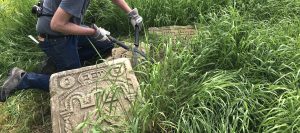
Shears cutting grass around headstones in the old cemetery of Rohatyn. Click image for time-lapse video. Images © RJH.
Cost to maintain: Only a few hedge shear types include replaceable blades, and only straight-blade versions can be sharpened easily with a file. Normally, maintenance is limited to cleaning the blades, and for some models oiling and tensioning the pivot.
Tool life: Most hedge shears are durable, and see limited use, so if not misused a pair can last for years.
Manufacturers: There are many brands available in western Ukraine; high-quality brands include Fiskars and Gardena, but there are others.
Notes: See the references page on this website for several excellent articles on selecting and using this and other hand tool types. See also the tool manufacturers’ websites for user manuals and other information on tool selection and use.
Scythes and Sickles
Long-handled scythes and short-handled sickles are agricultural tools which have been used globally for thousands of years and are still used in traditional farming in western Ukraine. Older volunteers from local Ukrainian communities who help in managing vegetation at Jewish burial sites sometimes use their scythes to mow tall grasses and light shrubs, and sickles are tools which are offered less-experienced workers who aim to cut dense but not woody shrubs. For experienced users, these tools can compete with motorized brushcutters, but it takes time to develop the skills to use these tools effectively.
Common variants: In addition to the two main categories based on size (large scythes for two-handled mowing and small sickles for one-handed cutting), variations within those categories are many, though the varieties found in western Ukraine are based on common European designs and are adapted to the agricultural crops which fare best there.
Best uses: Scythes and sickles are best suited to clearing vegetation similar to the agricultural crops they were designed for: long and tough grasses, and light, long-stemmed shrubs. Among the hand tools, scythes are the best for mowing large areas of any type of grass.
Other uses: As for many plant knives, these tools can be used to cut and clear a variety of vines and mixed vegetation, so long as hard materials are not present in the cutting path.
Issues: The thin blades adapted to cutting grasses and thin shoots of young shrubs are easily nicked and damaged by striking stones, hard wood such as small tree stumps, and other common obstacles in seldom-maintained cemeteries. For efficiency, the blades should be sharpened carefully and frequently, a task which inexperienced users do not quickly learn.
Cost to acquire: Fixed and folding sickles are available for US$10 to US$20 in western Ukraine; these tools typically have a blade length of about 40cm, sometimes very curved. Larger scythe blades of 60cm to 80cm length are available for US$40 to US$60; handles cost US$15 to US$40. Locally-made versions can be less expensive, usually of more traditional materials and forms.

Screenshots from a demonstration video on scythe use and sharpening.
Images © Bare Mtn Farm via YouTube.
Cost to maintain: Scythes must be sharpened frequently by honing with an abrasive stone, and peened occasionally with a hammer and anvil to form and harden the blade edge after extended use. Neither action requires expensive tools, but both experience and skill.
Tool life: Used to cut uniform grasses in the absence of hard obstacles, scythes and sickles can last for many years. However, the common problems encountered in cemetery maintenance can easily damage or ruin the blades on these tools, and the presence of headstones in some cemeteries all but precludes their use at those sites.
Manufacturers: Offner of Austria is a common source for scythes in western Ukraine, as Falci is for sickles, but many other options exist from both local and foreign fabricators.
Notes: See the references page on this website for articles comparing scythes to brushcutters for clearing grass and small shrubs.
Hand Saws
Hand saws for pruning are able to cut tree trunks and limbs which are larger and/or harder than loppers can handle, and in some cases small saws are easier to use for cutting dense growths of multiple large shoots from a single root network. Raking blades on modern hand saws for tree maintenance have larger and varied tooth profiles which can cut quickly and precisely through limbs.
Common variants: Hand saws come in a wide variety of styles for both single-handed and two-handed use. Single-handed versions may cut on the pull stroke or the push stroke, and may have straight or curved blades, fixed or folding handles, or very long telescoping handles for pruning high overhead. Two-handled versions are now limited to bow saws which can serve as a manual (and slow) alternative to chainsaws.
Best uses: Pruning tree branches over 5cm (2in.) in diameter, and hard dead branches, plus felling small trees up to several years old with cuts flush to the ground level.
Other uses: Pruning saws usually do not have blades with suitable teeth for cutting construction lumber, but can be used to make rough cuts to solve common problems with wood structures (fences, etc.) in and around cemeteries.
Issues: Using a hand saw continuously and for an hour or more is exhausting; the work should be passed between workers so that each can take a rest when tired.
Cost to acquire: Most hand saws available in western Ukraine cost US$10 to US$60, with many good options around US$35.
Cost to maintain: Only a small number of hand saws now have blades which can be sharpened or replaced, so maintenance is usually limited to cleaning the blade. Bow saw blades are designed for replacement, usually at a cost of about half a new complete saw.
Tool life: If a saw is used carefully, avoiding cuts with embedded metal obstructions and being careful not to bend the blade beyond its elastic limit, the saw can last for many years of occasional use.
Manufacturers: There are many brands available in western Ukraine; high-quality brands include Fiskars and Gardena, but there are others.
Notes: See the references page on this website for several excellent articles on selecting and using this and other hand tool types. See also the tool manufacturers’ websites for user manuals and other information on tool selection and use.
Axes and Hatchets
Axes and hatchets are hand tools used for splitting wood, and in cemetery care for felling small or medium-sized trees. The tools are similar; hatchets are usually smaller and intended for one-handed use while axes are larger and more commonly used with two hands during the strike. Most of the tasks for which these tools are good may be better performed with hand or power saws.
Common variants: Axes and hatchets useful in wood clearing work typically have a single blade, with the other end of the tool head usually a blunt face for hammering work. The haft (handle) of the tool is typically made of wood, but fiberglass and other plastic materials are also available. Axe blades for felling and chopping are wedges designed to cut across the grain of the wood, and usually leave a very coarse cut face on the tree.
Best uses: Felling small to medium-sized trees, and clearing tangled thickets of dense woody shrubs.
Other uses: Axes and hatchets can be useful for cutting felled trees and large branches to manageable lengths, when other cutting tools are not available.
Issues: Although the use of axes and hatchets seems simple, because the cutting head is heavy, the tools are dangerous. Accidents and injuries to hands, legs, and feet are common, especially when the user is inexperienced or tired. If power tools are not available or recommended, often a hand saw is a better alternative to an axe.
Cost to acquire: Axes and hatchets are inexpensive in western Ukraine, ranging from under US$10 to about US$80 depending on size and quality. A good-quality small to medium-sized hatchet about 40cm long and weighing about 1kg, typical for general-purpose one-handed use, costs about US$50.
Cost to maintain: The blade of an axe or hatchet can be readily sharpened with a file, sharpening stone, or grinding wheel; the tool is safest when it is sharpest. When badly worn or damaged, the entire head or handle can be replaced on some types.
Tool life: With care to avoid striking metal and stone with the blade, and keeping the tool away from excess water, an axe or hatchet can last many years with occasional sharpening.
Manufacturers: These simple tools are available from many manufacturers, including the hand tool makers named elsewhere on this page; good versions are made by “no-name” suppliers as well as the known brands. Inspection of the tool construction, especially the head-haft joint, is a good way to assess the tool’s quality.
Notes: See the references page on this website for several excellent articles on selecting and using this and other hand tool types. See also the tool manufacturers’ websites for user manuals and other information on tool selection and use.
Billhooks and Machetes
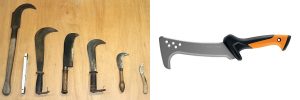
Traditional billhooks from Germany (left) and a modern billhook with saw blade on its back edge (right). Images from Wikimedia Commons and © Fiskars.
Billhooks and machetes are two cutting tools for green (live) wood which combine the features of axes and knives, serving a role in pruning large trees and felling small trees and most types of shrubs. Like all cutting tools, they can be dangerous to inexperienced users, but generally they provide more control of cuts than axes and more versatility than scythes and sickles.
Common variants: The two tools are similar in appearance and use, except that the machete has a long mostly-straight blade, while the billhook has a concave blade and cutting edge (with a more open curve than a sickle). Both tools have relatively thick and heavy blades to enable chopping of small-diameter wood as well as green tree and plant shoots. Some machetes have a saw edge on the back of the blade, a handy variant which is useful in wild mixed vegetation.

Machetes made by Truper and Cold Steel available in Ukraine from internet merchants. Images © Epicentr and Rozetka.
Best uses: Billhooks are very useful for tree care, as an alternative to loppers and light saws; they quickly and cleanly prune small branches which form over one to a few years. Machetes are good general-purpose tools for cutting through tangled wild growth which has accumulated at sites which have had no maintenance for several years.
Other uses: Machetes can be used for mowing small areas of dense grass (as an alternative to shears) and for a variety of other purposes, especially when cutting materials against a log or other soft wood.
Issues: A dull blade on either of these tools slows cutting and leaves ragged edges on the plants or trees. The fast-swinging blades on these tools can be dangerous in inexperienced hands, especially to the hand which is not holding the tool. New users often find entertainment in using these tools, not realizing the inherent dangers due to inattention and swing-through.
Cost to acquire: Machetes are readily available in western Ukraine from US$10 to US$50 depending on the manufacturer and the materials and finish of the tools. Billhooks are less well known in the region, but many tools labeled as machetes are actually billhooks.
Cost to maintain: The only maintenance possible on these tools is sharpening, using a flat file for machetes and (typically) a half-round file for billhooks.
Tool life: A well-constructed machete or billhook can last for years with occasional sharpening.
Manufacturers: Large suppliers in western Ukraine include Fiskars, Truper, and Cold Steel, but there are many other brands available at home and garden centers and from internet retailers.
Notes: See tool manufacturers’ websites for user manuals and other information on tool selection and use. Internet browser searches are quite fruitful for information and videos on these tools.
Rakes
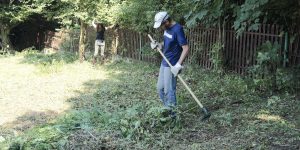
A volunteer gathers cut vegetation with a steel garden rake in Rohatyn’s new Jewish cemetery. Photo © RJH.
Heavy-duty rakes are used to gather or spread cut and fallen vegetation on the ground in and around burial sites. A wide variety of rake types are available for different purposes, but common cemetery tasks can be performed with just two or three types. Large cut vegetation (e.g. tree limbs) is usually best gathered by hand with just gloves, but brushcutters can produce large amounts of light- and medium-weight cut vegetation; rakes are indispensable for this task.
Common variants: All rakes are long-handled tools with heads designed to gather different weights of cut or fallen plant materials. A bow rake (also called a garden rake) typically has a steel or iron head with thick and stiff tines spaced 25mm or more apart; these are useful for gathering heavy and mixed vegetation. Lighter leaf rakes have many more tines spaced closer together; the tines are usually flexible metal or plastic good for gathering leaves, long grasses, and other light cut or fallen vegetation. Although the names of rake styles suggest their normal uses, construction details and tine flexibility determine their actual utility.
Best uses: Rakes are useful for gathering small and light cut or fallen vegetation on the ground to make it easier to carry away for disposal or mulching. Branches, shrubs, and thick grasses which are not easy to gather by hand can be quickly heaped with rakes.
Other uses: Rakes can also be used to spread gravel, mulch, and other ground cover materials, and to separate intertwined plants such as vines and shrubs from each other.
Issues: A single rake type usually does not easily gather all types of cut and fallen vegetation: the tines of garden rakes are too stiff and spaced too far apart to gather grasses well, and leaf rake tines are too flexible to gather heavier materials. It is usually best for a project to keep at least two types of rakes available for use throughout the work season.
Cost to acquire: Light rakes are available in western Ukraine for as little as US$2, but better-made and heavier-duty versions suitable for extended use in hard conditions typically cost between US$10 and US$20; rakes costing up to US$50 are rarely a good match for the rough conditions of cemetery care. In the region, it is common to purchase rake handles and heads separately, and then fasten them with screws.
Cost to maintain: The only maintenance possible on most rakes is replacement of either the head or the handle when it becomes damaged. Rake damage is common in the rough conditions of cemetery care, so choosing rakes which can accept new heads or handles is wise.
Tool life: A well-built rake can last a year or more of cemetery work, but it’s best to be prepared to replace parts or entire rakes yearly.
Manufacturers: Brand is not important in selecting rakes, and good versions are made by both foreign and local manufacturers; construction is they key, and can be judged visually at the time of purchase. Local building supply shops can advise based on their experience with their stock.
Notes: See the references page on this website for several excellent articles on selecting and using this and other hand tool types. See also the tool manufacturers’ websites for user manuals and other information on tool selection and use.

Rakes in use cleaning and clearing at Jewish cemeteries and mass graves in western Ukraine. Photos © RJH.
Shovels
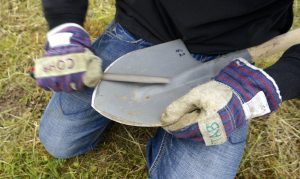
Sharpening a shovel blade to use as a knife for cutting poisonous giant hogweed plants at a mass grave site. Photo © RJH.
Garden shovels are general-purpose tools for cutting and lifting sod, soil, and aggregate materials (gravel, wood scraps, glass and other debris) by hand, and moving the materials over short distances. Because of the halakhic prohibition on disturbing the earth over graves, shovels find few uses at Jewish burial sites, but they can be helpful in constructing features in and around burial sites (e.g. fences, retaining walls, memorials), repairing damage to sites from weather or misuse, and some special purposes.
Common variants: Shovels available in western Ukraine and useful for work at Jewish burial sites come in two blade varieties: a spade or digging shovel, which has a pointed or rounded working edge, and a square or transfer shovel, which has a straight working edge; both blade types have bowl-shaped scoops to carry material. Handles are most commonly made of wood, but fiberglass versions are also available. Handle lengths vary from medium (about a meter overall, typically with a D-handle at the end) to long (1.5 meters overall, or more); the shorter length can be useful when moving dense materials.
Best uses: Shovels are most commonly used for new construction and repair of fences, walls, walkways, and memorial monuments at Jewish burial sites. They can also be used when removing some kinds of garbage and debris.
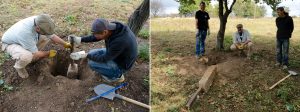
A shovel used to remove a concrete animal tether anchor at the old Jewish cemetery of Rohatyn. Photo © RJH.
Other uses: A sharp spade is useful for safe cutting and moving of poisonous plants such as giant hogweed, so that they do not spread at the burial site and do not injure workers and visitors at the site.
Issues: Project leaders should ensure that everyone working at a Jewish burial site is aware that soil over graves must not be removed by shovels or any other means.
Cost to acquire: Suitable shovels are available in western Ukraine from about US$5, with or without a handle, but better-quality versions with fiberglass or metal handles typically cost between US$10 and US$25.
Cost to maintain: Shovels used for cutting sod and hard soil need a sharp edge, and spades used to control poisonous plants should have very sharp blades to cut the plants cleanly. Edges of shovels can be maintained with an ordinary file.
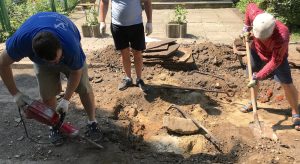
A square shovel working with other tools to extract Jewish headstones from a street in Lviv. Photo © RJH.
Tool life: The useful life of a shovel can vary significantly depending on how the tool is built, used, and stored. The weakest part of most shovel designs is the head attachment to the handle; usually the rivets or screws used for attachment are the first components to fail, though they can sometimes be easily replaced. Otherwise shovels usually last for several years, until the handle degrades from weathering or is broken from misuse.
Manufacturers: Fiskars, Foresta, and Gardena all make many good shovels, but there are also other good varieties available from less-well-known makers. Building supply shops in smaller towns rarely have the highest quality shovels, but the shovels they do sell are normally inexpensive and very serviceable for occasional cemetery work.
Notes: See the references page on this website for several excellent articles on selecting and using this and other hand tool types. See also the tool manufacturers’ websites for user manuals and other information on tool selection and use.
Miscellaneous and Specialty Tools
There are many other types of hand tools which may be useful in a few projects at Jewish burial sites in western Ukraine, but are not covered here because their use is rare or often impractical for typical vegetation cutting and clearing work at these sites. Examples include specialized tree pruning tools, grass mowers, weeders, trowels, etc. Some of these tools may find greater use in mature cemetery projects with designed landscaping and frequent maintenance; others may be used only once to clear unusual problems at the site.
Tools used to sharpen and maintain cutting and other common tools described here are important, but not detailed here. Examples are files and stones for renewing rough and fine edges on cutting blades, pliers for straightening bent blades and rake tines, screwdrivers and hammers for attaching tool heads to handles, adjustable wrenches, etc. Every project which uses hand tools for cutting and clearing vegetation will need a small collection of these tools, which are available at home and garden centers, tool supply shops, and bazaars.

Tarps used to make a clean work site (foreground) and for carrying cut vegetation (rear), shown with bags for carrying tools and supplies. Photo © RJH.
Other common aids and supplies which support clearing projects include heavy-duty strapped bags for collecting and carrying the tools, flexible tarps (for collecting and dragging cut vegetation, and as a clean work space or for resting breaks for workers), buckets (for collecting and carrying garbage and construction debris), automotive towing straps (for lifting and dragging heavy construction debris, fallen trees, etc.), stiff plastic brushes and scrubbing sponges for cleaning dirt and plant sap from cutting tools, and heavy-duty garbage bags for collecting miscellaneous garbage and debris for removal.
In addition to gloves, other forms of personal protective clothing may be needed for workers using some of the above tools, including safety glasses to protect against flying debris from axes, hatchets, and machetes, plus pads to cushion knees during hours of work close to the ground. Well-stocked first aid kits are highly recommended for all cemetery clearing projects, plus insect repellent, sunscreen, and drinking water. See the guide page on this website for more information about common pests encountered while cutting and clearing vegetation.
Power Tools
Power tools, also called motor tools, use gasoline engines or electric motors to significantly speed the work of cutting vegetation, or to enable clearing work which cannot easily be done with hand tools. Because most Jewish burial sites in western Ukraine are remote from sources of electricity, gasoline engines are usually the preferred power source for their versatility, but electric motors are easier to maintain and both cleaner and quieter to operate, so should be considered where practical. Electrical tools may be corded (connecting to AC power outlets via long electrical extension cords) or cordless (powered by batteries with high energy capacity); each choice has different advantages and disadvantages. Only a few key power tools are described here, but when used in concert with selected hand tools, those power tools can handle most of the common vegetation clearing tasks at cemeteries and mass graves. Safety risks are much greater with power tools than with hand tools, as is the need to wear protective eye shields and clothing. Training and experience are important to both effective and safe use of the tools, much more than most new users of power tools realize.
Brushcutters
Motorized brushcutters, also called string trimmers or “weed whackers”, and known in Ukrainian as “motor scythes”, are a class of general-purpose tools used for mowing thick grass and chopping light to medium shrubs and vines at or near the ground. Fitted with various types of working heads (string spindles, blades, etc.), the tools are capable of cutting and clearing most types of wild ground vegetation encountered at Jewish burial sites in western Ukraine.
Common variants: The most common brushcutter format is composed of a light high-speed engine, a drive shaft, and a driven string head; short lengths of plastic string extending from the head whirl at high speed and cut through light ground vegetation. Alternative heads use short plastic knife blades for the same purpose of cutting grass and light weeds, multi-bladed steel knives for cutting heavier shrubs and vines, and circular saw blades for clearing woody shrubs and trees of small to medium diameter. Engines suitable for sustained work in the typically rough conditions of occasional work at burial sites range in power from about 1kW to 2kW; heavy sawing work can need up to 3kW engines. The weight of medium- and high-power machines necessitates wearing a support harness, and all of the tools should only be used with face shields and hearing protection. Trimming string is available in several diameters and cross-section profiles; larger diameters are more effective in heavy grass and brush but require more engine power to cut at speed; square and star-shaped string types have sharp edges which improve cutting. String is less effective at cutting stiff shrubs, steel knives cut grasses very poorly, and only circular saw blades (or chainsaws) can cut through woody stems larger than about 15mm diameter, so there is no universal brushcutter head; interchangeability of tool heads and quick replacement of worn edges is essential to these tools’ versatility. Some brushcutters are designed for even greater interchangeability of the working end, to allow attachment of chainsaw bars, hedge trimmers, cultivators, and more.

Many hands using brushcutters to clear wild grasses and light shrubs in Rohatyn’s Jewish cemeteries. Photos © RJH.
Best uses: Brushcutters with string heads excel at mowing grasses of all types and lengths plus many types of wild shrubs and vines. If used carefully and at low engine speed, they can trim light vegetation cleanly around headstones without damaging the stone surface. Bladed knife heads chop through heavier vegetation well, provided the growth is not too mature and woody.
Other uses: With an attached string head, a brushcutter can clean and precisely define the edges of landscaping ground cover plantings, or grind mold and lichen from concrete and stone surfaces. Large circular saw blades adapted to heavy-duty brushcutters can cut through heavier woody undergrowth beneath tree canopies, although this version of the tool is quite dangerous to use.

Brushcutter damage from overheating: a cracked circular saw blade, and melted trimming string. Photos © RJH.
Issues: Attempting to use a brushcutter beyond its power limit can overheat and damage the engine; for the typical case in western Ukraine of a cemetery which sees only occasional clearing care, brushcutters must be worked slowly through dense grass, shrubs and vines to be effective. Small tree stumps and other woody, rocky, or metallic objects hidden in overgrown vegetation can damage steel blades and repeatedly break trimming string; hard strikes with blades can also damage the head gears. Poisonous plants at a work site should be removed by hand before using brushcutters, as the spinning string or blade will otherwise spray poisonous plant sap over a wide area and any workers in the vicinity. Injury to users and bystanders, and damage to headstones and other cemetery features as well as the tool themselves, are serious risks when used by untrained or immature workers.
Cost to acquire: All brushcutters available in western Ukraine are imported, primarily from western Europe and China; prices in Ukraine are comparable to those beyond the borders. Gasoline-powered machines suitable for work at burial sites range in cost from about US$80 to US$1000; a high-quality machine powered by a 1.5kW engine (suitable for all but the heaviest work) costs around US$400 to US$600. Second-tier machines branded by Chinese manufacturers offer high power-to-weight ratios but lower reliability; the low purchase price of these machines can be attractive to new projects as “starter” tools with which to gain experience before buying tools intended for long-term use. Engines for combination systems which accept a wide variety of working tools cost more than dedicated brushcutters, but are less expensive overall than a collection of single-use tools for many tasks. String heads range from US$15 to US$40, and string typically costs between US$0.10 and US$0.20 per meter when purchased in bulk; these running costs are very small compared to the investment in the basic machine. Steel bladed brushcutter knives range in cost from US$10 to US$50.
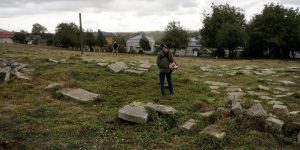
String trimmers carefully clearing around recovered headstones in the old Jewish cemetery of Rohatyn. Photo © RJH.
Cost to maintain: Common replacement parts (e.g. filters) for brushcutters are inexpensive, only a few US dollars each, and rarely needed. Most common adjustments and sharpening of tool edges can be done by users with simple tools. Annual professional inspection and service for heavily-used machine tools is very reasonable in western Ukraine, typically US$50 or less. Brushcutters consume string, gasoline, and motor oil in normal use, at a rate of less than US$100 per hectare of mixed vegetation for a single seasonal clearing.
Tool life: Used conscientiously, brushcutter engines and drive systems can last for many hundreds of hours with only light service (cleaning, changing air and fuel filters, lubricating head gears). String heads wear slowly, needing replacement only after a few hundred hours of normal use. Steel knife blades can be sharpened with a flat file and kept in useful service for a few hundred hours, if no hard objects are struck which bend the knife.
Manufacturers: Known quality manufacturers of gasoline-powered tools with distributors in western Ukraine include Stihl, Echo, Forte, and Daewoo; many other large manufacturers offer a wide range of brushcutters and accessories. Lighter-duty brushcutters with corded or battery-driven electric motors are available from Stihl, Makita, Ryobi, and other brands.
Notes: See the references page on this website for several excellent articles on selecting and using this and other motor tool types. See also the tool manufacturers’ websites for user manuals and other information on tool selection and use.
Chainsaws
In vegetation-clearing work at burial sites, chainsaws are used specifically for cross-cutting woody stems, branches, and trunks of small to large trees and large shrubs. Chainsaws are as dangerous as their notorious reputation warns, yet for their speed in changing the appearance of wooded landscapes they are revered by some. Except in initial remedial clearing of neglected cemeteries and some sites which envelop dense groves, the use of chainsaws at burial sites should be limited to a few specialized tasks, many of which can be performed instead by hand saws (although more slowly).
Common variants: Chainsaws for use in cemeteries and wooded surroundings of mass graves all follow the most common form, varying only in engine size, bar length, chain type and materials, and a few features for simplifying engine starting, chain tensioning, and safer use. For projects in most cemeteries, which have few or no large trees, if a chainsaw is needed at all the best option is often a small model which is lighter, safer to use, and lower cost. Although most chainsaws use gasoline engines similar to those in brushcutters, some chainsaws are available with electric motors; the choice for each project will normally depend on what power source is used in brushcutters and other power tools at the site.
Best uses: Chainsaws are designed for felling trees, cutting large and medium-sized branches, and cross-cutting other wooden objects such as downed branches, to size them for removal. The tools can quickly shape large trees and thin groves of trees, fell thick and multi-stem woody shrubs, and clear tangled or thorny thickets. Chainsaws can handle nearly all of the tasks for which hand saws are used, but often much quicker and with less effort; for large tree management, chainsaws are often the only practical choice.
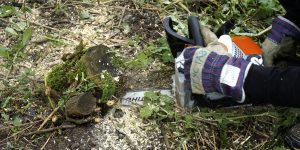
Cutting stumps flush or below ground level exposes the saw chain to abrasive sand and soil. Photo © RJH.
Other uses: At the expense of considerable service time and replacement saw chains, chainsaws can be used to cut the woody stumps of small trees and large shrubs felled by other tools. Chainsaws are usually the fastest tool for cutting large numbers of these stumps to the ground, not counting the tool service time.
Issues: The safety risks of using chainsaws are well known, yet inexperienced users are attracted to the tools because of their inherent power; this is obviously a dangerous combination which must be actively managed by project leaders. Chainsaw manufacturers and independent organizations have produced many written and video guides to safer use of chainsaws, but to avoid trail-and-error learning, if a chainsaw is present at a work site only experienced users should control the tools and guide new users in their safe operation, and nobody without past experience felling trees should be allowed to do this specialized task. In addition to protecting against accidental body contact with a moving saw chain, users should wear face shields and hearing protection during use, and be aware of other workers in the vicinity. Chainsaws are not effective in cutting flexible wood, for example long branches away from the tree trunk or woody vines and slender shrub stems. Most chainsaws are occasionally hard to start, prone to clogging with wood debris, and in need of frequent chain tensioning, cleaning, and lubricating. Although it is important to cut small trees and large shrubs flush to or below ground level (to avoid small stumps becoming trip hazards and interfering with smooth brushcutter work), the abrasive nature of soils rapidly dulls saw chains – in as little as a few minutes’ time – so that chains must be sharpened and all chain and drive components (including bars, sprockets, and clutch drums) replaced very frequently in this type of work, rendering chainsaws almost useless for one of their most important tasks in cemetery work.
Cost to acquire: Small gasoline-powered chainsaws are very reasonably priced, typically around US$200 for a high-quality model of about 1.5kW power, and US$60 to US$100 for second-tier models. Electrical chainsaws are even cheaper, though typically lower-power.
Cost to maintain: Chainsaws must work in dirty environments of their own making, with wood chips and debris dragged and thrown by the chain into all exposed working parts, the air intake, and switches and other controls. As a result, cleaning and replacement of parts is needed much more often for chainsaws than for brushcutters. None of the replacement parts is expensive, but the cost adds up in heavy use. A typical steel chain for a small chainsaw costs around US$7, with the longer-lasting carbide-tipped version about 4x that cost; a 35cm chain bar costs about US$20; a chain sprocket/drum costs about US$8; other parts also wear quickly in harsh environments: chain tensioning gears, needle bearings, etc.. Steel chains can be sharpened by professionals for US$2 to US$4.
Tool life: The engine which powers a small chainsaw should normally last for several years if maintained well, but the case, controls, and especially the chain drive components can wear out in less than a hundred hours of heavy use. When working in abrasive environments, it is not unusual to replace the chain four to eight times per day, and the chain bar once. If cemetery use is limited to tree care and trimming well above the ground, all drive components will have much longer life; even chains may not need sharpening or changing more than once per day. Cleaning the tool frequently with a soft brush or even just blowing out wood chips and dust from the drive area will extend the life of the tool and its components.
Manufacturers: The same manufacturers of gasoline-powered brushcutters also make chainsaws, including Stihl, Echo, Husqvarna, Forte, and many others of similar or lower quality. Electrical chainsaws are made by nearly every fabricator of electrical construction tools, including Stihl, Makita, Bosch, Ryobi, Black+Decker, and other brands.
Notes: See the references page on this website for several excellent articles on selecting and using this and other motor tool types. See also the tool manufacturers’ websites for user manuals and other information on tool selection and use.
Reciprocating Saws
As an alternative to chain saws for powered wood cutting, reciprocating saws may serve in many light work situations at burial sites. Although usually not appropriate for felling trees larger than 10cm diameter, reciprocating saws with appropriate blades can make quick and easy work of smaller trees and branches, woody shrubs, and other common light-duty sawing purposes. Designed for building construction and demolition work, the tools have been well adapted to garden and landscape maintenance.
Common variants: All reciprocating saws employ electrical motors; given the remote location of most Jewish cemeteries in western Ukraine, this means the tools are powered either by high-energy-capacity batteries or are corded to a generator. The style of reciprocating saw best adapted to tree and shrub cutting is also called a sabre saw, with a replaceable cantilevered blade. Pruning blades for cutting green (live) wood typically have large raking teeth, like the hand saws described above, and may be 15cm to 30cm long; in harsh and abrasive conditions, these blades tend to last much longer than saw chains. A few specialty tool and blade combinations mimic the shape of common hand rip saws, but these are not very effective in tree work. Blade and cut control for standard reciprocating saws is especially good compared to chainsaws, and as good or better than hand saws.
Best uses: Pruning larger trees and felling small trees and large shrubs; reciprocating saws cannot effectively cut trees or limbs larger than about 10cm diameter, but at this size and below they serve well vs. chainsaws and hand saws.
Other uses: Fitted with different blades, reciprocating saws can cut dense hard wood, metal, plastics, and other materials; with an appropriate power source, the tool has broad sawing uses.
Issues: Reciprocating saws are relatively safe power tools, and a short training session is usually all that is needed for new users. Arranging the power source (AC supply or charged batteries) is usually the only serious issue affecting these tools.
Cost to acquire: For unknown reasons, the cost of reciprocating saws and batteries is much higher in Ukraine than elsewhere in Europe or the US, and the selection is much narrower, typically missing the more powerful and higher-quality models. In Ukraine the cost is better from tool supply specialists than from large internet retailers. High-power corded or cordless reciprocating saws should cost between US$100 and US$200, with high-capacity lithium-ion batteries (5Ah or more) typically US$75 to US$100. Good-quality 30cm pruning blades should cost US$2 to US$5 each when purchased in bulk; carbide blades may cost more, but the essential feature of good blades for tree work is toughness (a product of the blade construction).
Cost to maintain: Many current reciprocating saws are built with brushless motors, so there are almost no maintenance tasks associated with these tools apart from occasional cleaning, changing blades, and if so equipped, charging batteries.
Tool life: Corded versions of reciprocating saws are durable and can be expected to last for many years. Cordless versions have the weakness of battery life, but good-quality lithium-ion batteries for these tools should last for 300 or more charge-discharge cycles. Blades can last up to a day in abrasive work, or many days in cutting above the ground.
Manufacturers: Most European, Japanese, and American brands are available in western Ukraine, though seldom their entire product lines. Brands on offer include Bosch, Makita, DeWalt, Milwaukee, and others with Ukrainian or Chinese names.
Notes: See the references page on this website for several excellent articles on selecting and using this and other motor tool types. See also the tool manufacturers’ websites for user manuals and other information on tool selection and use.

Before and after cutting a complex of shrub stumps to the ground, to suppress new growth and eliminate trip hazards. Photos © RJH.
Miscellaneous and Specialty Tools
Home and garden supply shops, tool suppliers, and some power tool manufacturers provide a range of personal protection equipment and clothing appropriate for power tool use, including gloves, safety eyeglasses, face shields, hearing protection, and more. For heavier work with trees, cut-resistant trousers, head protection (hard hats), and safety boots may also be necessary.
Because of the uneven ground surface and numerous hard obstructions in most Jewish cemeteries and mass grave sites in western Ukraine, some power tools are seldom useful at these sites even though common for maintenance of gardens and parks. One example is powered lawn mowers for cutting grass, although the heavy-duty brush hog is a variant which could be used for rapid leveling of wild vegetation in some cemeteries.
The rare need for other common garden tools also makes them an inappropriate purchase for most cemeteries. These less-needed tools include powered hedge trimmers, woodchippers and shredders, cultivators, and more. The same manufacturers of brushcutters make many of these tools as well, providing a research path if a project is in need of one of these types of machines.
How and Where to Get Tools
Some projects may be able to borrow tools for occasional vegetation clearing from other heritage preservation organizations, especially through exchanges of volunteers in alternating site clearing events; both the Lviv Volunteer Center and Rohatyn Jewish Heritage have brought hand and power tools for volunteers to use at events they have organized or participated in during past years, and the municipal administration in Kalush (Ivano-Frankivsk Oblast) provided tools and city workers at a community event which cleared the Kalush Jewish cemetery in 2018. This type of tool loan enables tool owners to train new users and monitor tool use for safety and to minimize damage from misuse.
Rentals of vegetation clearing tools is uncommon in western Ukraine, probably because of liability for injuries and the relatively high risk of tool damage. This is unfortunate, because most Jewish burial site projects need clearing tools only occasionally, typically a few times per year, so the rental model would be a helpful option for many projects. One option for rental of chainsaws and other equipment is Paschenko, in Lviv.
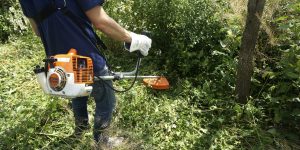
Durable power tools are available at specialty tool shops and large home and garden centers in western Ukraine. Photo © RJH.
However, the need for wild vegetation control in Jewish cemeteries is long-term at most sites, until proactive landscaping efforts can replace fast-growing grasses and weeds with slower-growing ground cover plants, plant-suppressing landscape textiles and mulches, and inorganic materials such as crushed rock. The long-term need for cemetery care means that investing in vegetation clearing tools with a plan to maintain them and budget for occasionally replacing them is a reasonable strategy for many projects. Then the question is where to buy tools which are well matched to the needs of the site(s).
Shops organized to sell name-brand tools are best for purchasing high-quality power tools (and sometimes hand tools), because they can order tools which they don’t have in stock, and they usually also service worn or damaged tools from the brands they carry. Some of these shops are distributors for a single brand family (e.g. Stihl/Viking), others for a range of brands (including Husqvarna, Makita, Echo, Stiga, and many others). Examples in western Ukraine include the Stihl network, the Kvitka chain, Planeta Instrument, and i-West Tools. Outside of the largest cities, many smaller cities and some towns have small tool shops which can compete in quality and price with the chain stores, and offer tool service options also.
A wide variety of hand and power tools are available for viewing and purchase at large home and garden centers in the region, including Epicentr (with ten stores in western Ukraine including three large stores in Lviv), Nova Liniia, and others. Bazaars and specialized markets in larger cities can also be useful sources for both new and used tools; often the sellers in specialized markets are knowledgeable about the tools they sell and can advise about the durability of the tools (and their weaknesses) based on their and their customers’ experience.
Thanks to efficient and inexpensive commercial delivery services such as Nova Poshta, large Ukrainian internet retailers may also be a source for all but the largest hand and power tools. There are many such companies in Ukraine; two large ones which carry tools for vegetation clearing are Rozetka and Spinelli. Often the range of available tools is limited to lighter-duty tools, and prices can differ very significantly, so it is important to compare tool model numbers with manufacturers’ specifications and prices between a few sources before committing to a purchase. Many of the brick-and-mortar tool distributors also have internet shops as well, giving reach across Ukraine for stores which are based in Kyiv or elsewhere outside western Ukraine.

